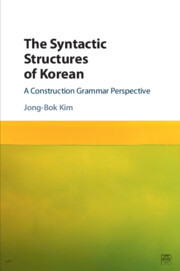The Syntactic Structures of Korean A Construction Grammar Perspective
Auteur : Kim Jong-Bok

Date de parution : 12-2022
Ouvrage de 359 p.
15.2x22.9 cm
Disponible chez l'éditeur (délai d'approvisionnement : 14 jours).
Prix indicatif 35,47 €
Ajouter au panierDate de parution : 07-2016
Ouvrage de 360 p.
16x23.7 cm
Disponible chez l'éditeur (délai d'approvisionnement : 14 jours).
Prix indicatif 111,54 €
Ajouter au panier


